A VISION FOR THE FUTURE
OF UTILITY LOCATING
OF UTILITY LOCATING
Utility services are the life blood of modern society. Every year, hundreds of thousands of buried gas, electrical, water, wastewater, and communications services are damaged from digging up the ground. These utility strikes cause service interruptions, incur substantial costs, and threaten both life and property.
At SeeScan, we want to go beyond the status quo. We see a future where every utility is accurately mapped to protect our vital infrastructure – and we see this happening automatically as an integral part of every utility locate.
Our vision is a locating system smart enough to determine the precise geospatial position and depth of buried utilities without human interpretation and automatically generate an accurately detailed map.
Underground Evolved:
The Geo Locating System
The Geo Locating System
For over two decades, we have been dedicated to creating a fully integrated, multi-sensor utility mapping system. The Geo® Locating system uses advanced signal processing to gather a substantial quantity of data about the electromagnetic signals in the locate area. The system generates a comprehensive map of utilities, backed by data gathered from the locating equipment. By using data, instead of human interpretation, the Geo Locating system is able to determine the position of the utility’s horizontal position and depth with a high degree of accuracy.
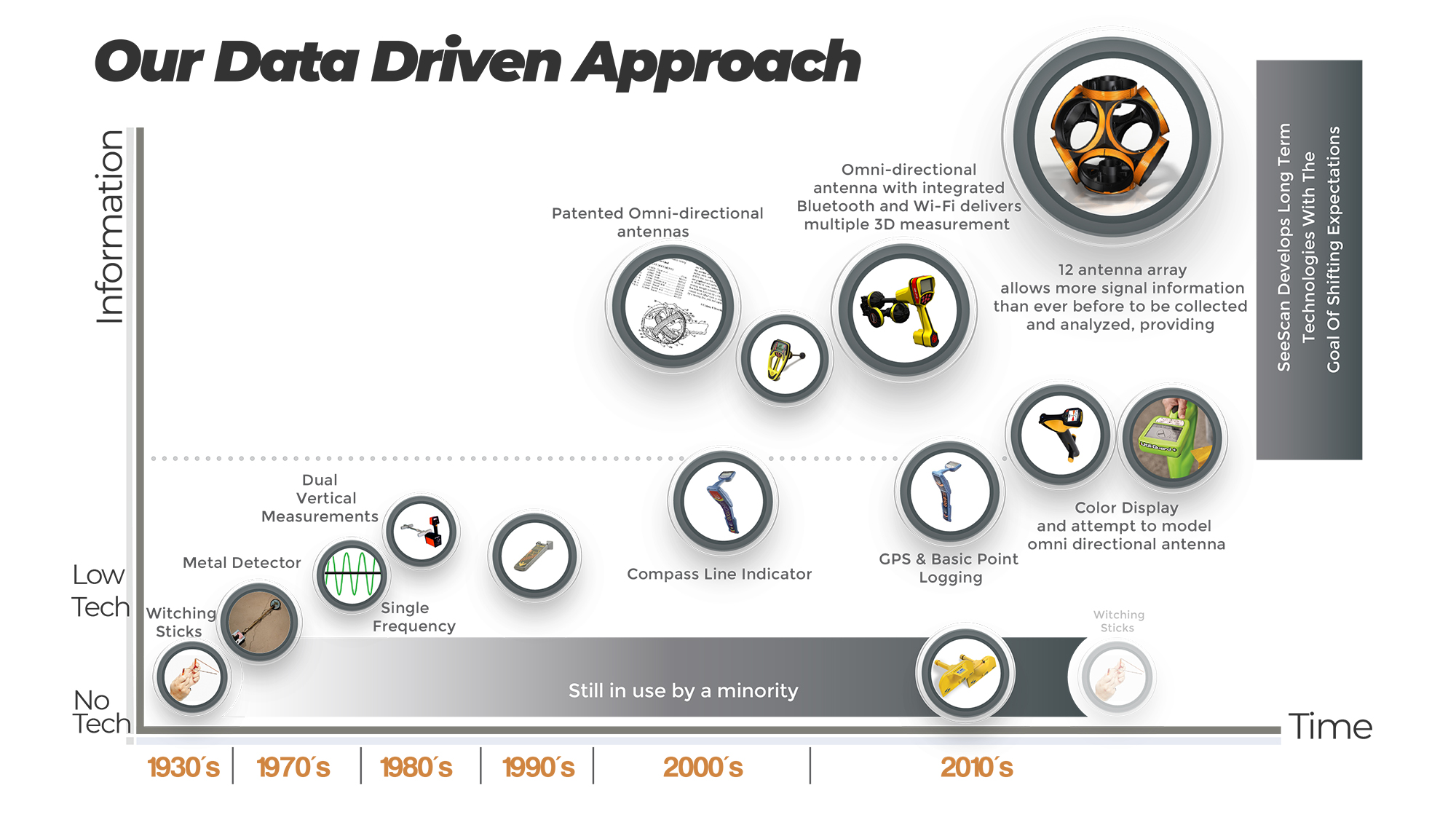
OUR LOCATING PRODUCT JOURNEY

THE GEO LOCATING SYSTEM COMPONENTS
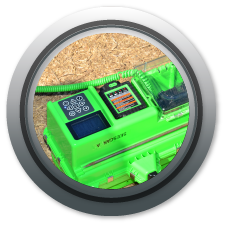
GEO LOCATING TRANSMITTER
The Geo Locating Transmitter is the first of its kind. In conventional utility locating, finding the “right” frequency for a given locate may be difficult to determine. This transmitter takes guesswork out of the equation by applying multiple low, medium, and high frequencies onto a target utility simultaneously. Multiple transmitters can be hooked up to different utilities in the area to supply more information to the receiver.
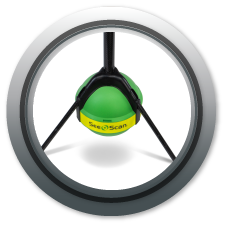
GEO LOCATING TRANSMITTER
The Geo Locating Transmitter is the first of its kind. In conventional utility locating, finding the “right” frequency for a locate may be difficult, or even impossible, to determine. This transmitter takes guesswork out of the equation by applying multiple low, medium, and high frequencies onto a target utility simultaneously. Multiple transmitters can be hooked up to different utilities in the area to supply more information to the receiver.

GEO LOCATING RECEIVER
The Geo Locating Receiver represents a revolution in locating technology. This receiver includes an advanced antenna array and multiple motion and environmental sensors, giving it the ability to detect a broad range of all actively applied and naturally occurring passive frequencies at once. Onboard GPS logs the receiver’s position throughout the locate. The graphical display and audio cues help guide the operator over the utility’s position. All signal and positional data is captured onto a USB for upload into SubView.
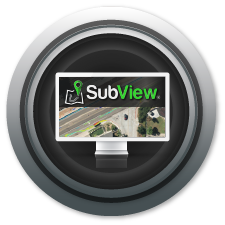
SubView™
SubView is a web-based GIS platform for creating and sharing utility maps based on the data gathered from the Geo locating receiver. SubView processes all data—including information about all detected actively applied and naturally occurring passive frequencies, as well as environmental and positional information. It then produces a complete map of utilities in the area, including each utility’s estimated horizontal position and depth. Each locate is stored in the Cloud and can be customized with notes and jobsite images, and is designed to be shared easily with key stakeholders.

UFID MARKING TECHNOLOGY
UFID (underground field identification) technology represents the latest in RFID marker technology and non-metallic utility locating. The Geo Locating receiver transmits a continuous high output signal on the 13.56MHz Industrial Medical Scientific band (IMS), a frequency that’s higher than the receiver can detect; in other words, the receiver transmits a signal that it does not receive. The signal excites (turns on) the UFID device, which then re-broadcasts the signal at a much lower frequency that can be detected by the receiver.
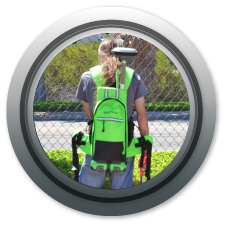
GEO TRACKPACK WITH HIGH PRECISION GPS
Determining the utility’s position requires knowing where the receiver is during the locate – both in reference to the signal and in reference to the world. The Geo Locating receiver’s onboard GPS continually logs its position throughout the locate. For greater world position accuracy, the Geo TrackPack is designed to carry a high precision GNSS device, giving the Geo Locating receiver access to additional navigational satellites beyond the GPS system.

GEO LOCATING RECEIVER
Geo Locating Receiver represents a revolution in locating technology. It is capable of detecting all nearby electromagnetic signals at a range of frequencies simultaneously, including actively applied and passive frequencies. Onboard GPS logs the receiver’s position with respect to the detected signals, and its visual display guides the operator over the target utility. The receiver automatically plots the utility’s estimated positions at each frequency, independently of operator interpretation. The receiver captures all data in real time onto a USB for post-processing with the utility mapping platform, SubView.

SubView™
SubView is a web-based GIS platform for creating and sharing utility maps based on the data gathered from the Geo locating receiver. SubView processes all data—including information about all detected actively applied and naturally occurring passive frequencies, as well as environmental and positional information. It then produces a complete map of utilities in the area, including each utility’s estimated horizontal position and depth. Each locate is stored in the Cloud and can be customized with notes and jobsite images, and is designed to be shared easily with key stakeholders.

UFID MARKING TECHNOLOGY
UFID (underground field identification) technology represents the latest in RFID marker technology and non-metallic utility locating. The Geo Locating receiver transmits a continuous high output signal on the 13.46MHz Industrial Medical Scientific band (IMS), a frequency that’s higher than the receiver can detect; in other words, the receiver transmits a signal that it does not receive. The signal excites (turns on) the UFID device, which then re-broadcasts the signal at a much lower frequency that can be detected by the receiver.

GEO TRACKPACK WITH HIGH PRECISION GPS
Determining the utility’s position requires knowing where the receiver is during the locate – both in reference to the signal and in reference to the world. The Geo Locating receiver’s onboard GPS continually logs its position throughout the locate. For greater world position accuracy, the Geo TrackPack is designed to carry a high precision GNSS device, giving the Geo Locating receiver access to additional navigational satellites beyond the GPS system.
VEHICLE HITCH
Passive locating has evolved. The Geo locating receiver includes advanced motion processing, enabling it to be used to passively locate utilities while driving a vehicle. This allows for a fast way to identify multiple utilities in an area without having to disrupt traffic. Operators can mount two Geo locating receivers to a custom vehicle hitch. A survey grade GNSS instrument hitched to the center logs positional data while the vehicle is in motion.
VEHICLE HITCH
Passive locating has evolved. The Geo locating receiver includes advanced motion processing, enabling it to be used to passively locate utilities while driving a vehicle. This allows for a fast way to identify multiple utilities in an area without having to disrupt traffic. Operators can mount two Geo locating receivers to a custom vehicle hitch. A survey grade GNSS instrument hitched to the center logs positional data while the vehicle is in motion.

KEY GEO LOCATING TECHNOLOGIES
OMNIFREQUENCY
TECHNOLOGY
How a signal appears is profoundly a function of its frequency. Applying and tracing a range of multiple frequencies simultaneously provides a more complete picture of the target utility as well as nearby utilities in the area. With Geo Locating, signal coupling onto other utilities in the area is not an obstacle to be avoided, but rather an opportunity to create a fuller picture of the buried infrastructure in the area.
ADVANCED
ANTENNA DESIGN
Geo Locating receivers use an array of omnidirectional antenna coils that are positioned around a shared center. The arrays enable the receiver to measure the direction that the signal is moving, its strength, and depth at the same time and from a single point in space, meaning you see what you need to know with every step you take. Most importantly, the instrument is able to measure the signal’s shape: again, an invaluable piece of information for the locating professional.
OMNIGRADIENT
LOCATING
The Geo Locating receiver’s omnigradient antenna array measures the signal gradient in all directions, revealing where and how an electromagnetic field changes in both direction and intensity in three-dimensional space. This provides a much more accurate indication of the utility’s position over relying on signal strength alone.
KEY GEO LOCATING TECHNOLOGIES
OMNIFREQUENCY
TECHNOLOGY
How a signal appears is profoundly a function of its frequency. Applying and tracing a range of multiple frequencies simultaneously provides a more complete picture of the target utility as well as nearby utilities in the area. With Geo Locating, signal coupling onto other utilities in the area is not an obstacle to be avoided, but rather an opportunity to create a fuller picture of the buried infrastructure in the area.
ADVANCED
ANTENNA DESIGN
Geo Locating receivers use an array of omnidirectional antenna coils that are positioned around a shared center. The arrays enable the receiver to measure the direction that the signal is moving, its strength, and depth at the same time and from a single point in space, meaning you see what you need to know with every step you take. Most importantly, the instrument is able to measure the signal’s shape: again, an invaluable piece of information for the locating professional.
OMNIGRADIENT
LOCATING
The Geo Locating receiver’s omnigradient antenna array measures the signal gradient in all directions, revealing where and how an electromagnetic field changes in both direction and intensity in three-dimensional space. This provides a much more accurate indication of the utility’s position over relying on signal strength alone.

